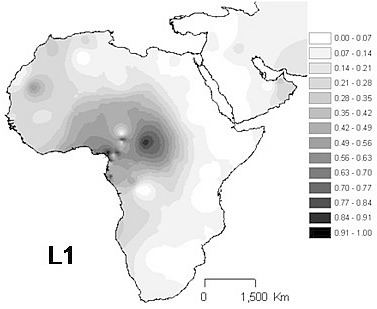Possible time of origin 107,600–174,300 YBP Ancestor L1-6 | Descendants L1b, L1c | |
 | ||
Defining mutations 3666, 7055, 7389, 13789, 14178, 14560 | ||
Haplogroup L1 is a human mitochondrial DNA (mtDNA) haplogroup. It is most common in Central and West Africa.
Contents
Origin
Haplogroup L1 is believed to have appeared approximately 110,000 to 170,000 years ago. Haplogroup L1 is a daughter of L1-6 and genetic marker changes are 3666, 7055, 7389, 13789, 14178 and 14560.
Although it is typically used to denote a group of lineages found within Africa, L1 is sometimes referred to as haplogroup L1-6. The latter is the macrohaplogroup that includes the majority of Africa-based clades and all haplogroups centered outside of the continent. Haplogroup L1-6 is the macrohaplogroup that includes subclades L1, L2, L4, L5, L6, and also L3 which gave rise to the two non-African haplogroups M and N. Haplogroup L1-6 and its only sibling haplogroup L0 are united by the matrilineal most recent common ancestor, (MRCA) of all living humans, Mitochondrial Eve. The existence of these two lineages, implies that Mitochondrial Eve had at least two daughters, one of whom is the maternal common ancestor of haplogroup L1-6 lineages.
Distribution
Haplogroup L1 is found most commonly in Central Africa and West Africa. It reaches its highest frequency among the Mbenga Pygmies.
Haplogroup L1 has been observed among specimens at the island cemetery in Kulubnarti, Sudan, which date from the Early Christian period (AD 550-800).
Subclades
L1 has two branches:
Tree
This phylogenetic tree of haplogroup L1 subclades is based on the paper by Mannis van Oven and Manfred Kayser Updated comprehensive phylogenetic tree of global human mitochondrial DNA variation and subsequent published research.
